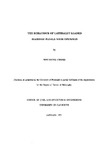The behaviour of laterally loaded masonry panels with openings
| dc.contributor.author | Chong , Vun Leong | |
| dc.contributor.other | School of Engineering, Computing and Mathematics | en_US |
| dc.date.accessioned | 2011-10-03T16:49:51Z | |
| dc.date.available | 2011-10-03T16:49:51Z | |
| dc.date.issued | 1993 | |
| dc.identifier | Not available | en_US |
| dc.identifier.uri | http://hdl.handle.net/10026.1/846 | |
| dc.description | Merged with duplicate record 10026.1/2818 on 07.20.2017 by CS (TIS) | |
| dc.description.abstract |
In recent years the use of masonry as a structural material has increased in advance of the necessary theoretical and corroborative experimental investigations. One aspect of structural masonry where particular problems have been encountered is the design of masonry panels subjected to lateral loadings. Research undertaken, principally in the United Kingdom and Australia, has led to the development of empirical methods of analysis applicable to solid rectangular panels. However, the effects of the presence of openings on the behaviour of a masonry panel has received scant attention. The aim of the research is to rectify this situation. The principal objective of the research is to put the design of this form of panel subjected to lateral load, on a more rational footing. To do this it has been necessary to investigate the behaviour of masonry panels with openings. The research can be divided in four stages. Firstly, an extensive literature survey has raised questions concerning the suitability of the current British Standard Code of Practice ,BS5628, and other design methods such as elastic plate theory, and empirical strip method, for the design of laterally load masonry panels. Secondly, a non-linear finite element analysis has been developed. The analysis is capable of analysing panels under lateral loading up to and beyond the peak load. The results obtained using the computer program were initially validated with the existing results from two previous laboratory investigations [1,2]. Initial analysis of the results from the experimental and theoretical studies highlighted areas where further investigation was required. In conjunction with the development of the computer program, the investigation involved the laboratory testing of 18 full scale panels. One of the major problems encountered was the determination of material parameters. In this work wallettes have been used to obtain flexural strength values, however the strength of the specimen is influenced by the size of specimens and the number of bed and perpend joints [3,4]. In order to clarify the position, a computer based statistics analysis similar to that reported by Lawrence [4], was employed to investigate the format of the specimens. Estimations of the single joint strengths from the wallette results were obtained from the analysis. Single joint strengths obtained from the statistics analysis were then used in the finite element analysis and comparisons with the experimental load-displacement relationships and the failure patterns made. A Monte-Carlo simulation of the finite element analysis was also carried out to investigate the effect of material variability on the failure strength of masonry panels. Good correlation has been obtained. Lastly, parameter studies using the finite element analysis and the experimental results have indicated that yield line method consistently over estimates the failure strength of masonry panels. However, the reduction of strength due to the inclusion of openings predicted by yield line is in a reasonable good agreement with the experimental results obtained. A simple formula for the design of laterally load | en_US |
| dc.language.iso | en | en_US |
| dc.publisher | University of Plymouth | en_US |
| dc.title | The behaviour of laterally loaded masonry panels with openings | en_US |
| dc.type | Thesis | en_US |
| dc.identifier.doi | http://dx.doi.org/10.24382/1306 | |
| dc.identifier.doi | http://dx.doi.org/10.24382/1306 |
Files in this item
This item appears in the following Collection(s)
-
01 Research Theses Main Collection
Research Theses Main


